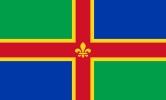Boston Friary

Boston Friary refers to any one of four friaries that existed in Boston, Lincolnshire, England.
The Augustinian Friary
[edit]52°58′18″N 0°01′09″W / 52.9717°N 0.0192°W
The Augustinian Friary was founded 1317/18 and was sited near St John's Churchyard in Skirbeck.[1] Land was acquired from Andrew son of Robert atte Gote or Gotere in 1318, John de la Gotere in 1327, John de Moulton and John Leeke in 1342.[2] There were twenty friars here in 1328.[2] It was Surrendered in 1539 to the Bishop of Dover[2] and leased in 1541 to Thomas Browne, but bought by the town in 1544/5[2] In 1573 the site was leased to Anthony Kime.[2] Today the greater part of the site is covered by the old Union Workhouse.[1]
The Carmelite Friary
[edit]First Friary 52°58′31″N 0°01′36″W / 52.9752°N 0.0266°W
Later Friary 52°58′31″N 0°01′32″W / 52.9753°N 0.0256°W
The Carmelites known in medieval England as the White Friars, were established in 1293 originally in Skirbeck, but later at a site off the High Street opposite Doughty Quay,[3] which they bought from John Parleben in 1308,[2] having been granted permission to erect a church by King Edward II.[2] They bought more land in 1315/16. In 1349 Simon Lambert gave them more land, and a year later they received four acres from Sir John de Orreby.[2] Following the Dissolution of the Monasteries, about 1544/5, the town of Boston purchased the White Friars site.[2]
The Dominican Friary
[edit]52°58′32″N 0°01′22″W / 52.9756°N 0.0227°W
The Dominicans were known in medieval England as the Shod Friars or more commonly the Black Friars. The Friary was founded in 1222.[4] In 1288 their buildings, along with a large area of the town, were burnt during St Botolphs Fair, and in 1290 they were given eight oaks from Sherwood Forest by the King.[2] In 1327 they were given a royal licence to build a subterranean aqueduct from Bolingbroke to their house.[2] The friary was forceably closed in 1539 in the Dissolution of the Monasteries, and in 1540 the land confiscated from the friars was granted to the Duke of Suffolk.[2] The refectory of the Dominican friary is the only part of any of the local friaries still in existence.[4] It is Grade II* listed, and houses the Blackfriars Arts Centre.[5]
The Franciscan Friary
[edit]52°58′29″N 0°01′18″W / 52.9748°N 0.0217°W
The Franciscans were known as the Grey Friars and their house was established at an unknown date prior to 1268.[2] According to Leland, the Franciscans mixed with the Esterlings (European merchants), and many were buried there. Among those was Wisselus de Smallenburg, a merchant from Munster, who died in 1340, and whose grave slab today lies in St Botolph's Church, Boston.[2] The friary was seized in 1539,[6] and valued at 44s. a year. While at first reserved for the King, it was then sold off to the town in 1544/5.[2]
References
[edit]- ^ a b Historic England. "Boston Austin Friary (353986)". Research records (formerly PastScape). Retrieved 24 May 2011.
- ^ a b c d e f g h i j k l m n o "British History Online". Austin Friars of Boston. Victoria County History. Retrieved 24 May 2011.
- ^ Historic England. "Boston Whitefriars (354007)". Research records (formerly PastScape). Retrieved 24 May 2011.
- ^ a b Historic England. "Boston Blackfriars (354004)". Research records (formerly PastScape). Retrieved 24 May 2011.
- ^ "British Listed Buildings". Blackfriars Arts Centre. English Heritage. Retrieved 25 May 2011.
- ^ Historic England. "Boston Greyfriars (354010)". Research records (formerly PastScape). Retrieved 24 May 2011.


